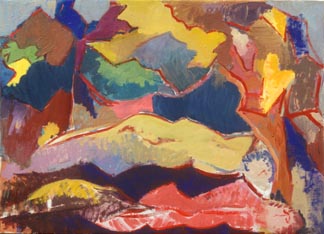It was Klee who opened me up to painting and who, for me at least, set the standard for what a painting can be. When I see a painting, I am comparing the levels of experience I have with it to the levels I have had with other paintings. I do not ask that a painting be like other paintings or that the experience be like past experiences. On the contrary, I want surprises and variety. I ask only that the experience be full, rich and deep.
The deep experience I am talking about is one in which, as the painting opens itself to me, and I, in turn, open to the painting, I feel a dialogue. And that dialogue is between the painting, myself and the larger tradition of painting—a tradition that is not bound by time or culture. I am talking about an experience that does not close down or isolate itself in a narrow set of contemporary beliefs but that touches on universals. This is the yardstick I carry with me when I engage with painting. It is not a tool that comes with being a critic. It is a tool that comes with looking at painting and with wanting to be open, engaged and curious before works of art.
Klee gave me a love of painting—painting as a tradition, not a style. Yet, as much as I favour Klee, when I visit the Louvre and I enter the Corot galleries it is Corot who steals my heart. And I love Corot most until I happen into the rooms of Poussin. And it is Poussin until I see Rubens or Titian or Bellini; or until I happen upon Cimabue, Van Eyck, Chardin or Fra Angelico; Claude, Rembrandt, Leonardo or Ingres. When I am with Mondrian, it is Mondrian I love. With Giacometti, it is Giacometti. Or it is Matisse, Braque or Vermeer. While in Egypt, it was Egyptian wall painting.
Having been asked to write about my 'three favourite living painters' I find that I am greedy and fickle. Every painter I love offers me something different—
Part of the pleasure of looking at a painter's work over time is seeing the progression and expansion of a particular vocabulary. Seeing new paintings by an artist whose work has already engaged me adds to my understanding not only of the new work but also of the paintings that have come before. I begin to understand and appreciate an artist's sources and subjects and hand, all of which become more familiar. I get closer to knowing and appreciating not only what compels him or her as a painter but also what compels me as a viewer. . . .
This ability to transform materials and to convey multiple metaphors at once is in part what captivates me in Deborah Rosenthal's new abstract landscapes of buried lovers. And it is what excited me in the exquisite show of Anne Truitt's painted wood columns and cubes at Danese last year. Truitt is a sculptor, but her solid beams of colour can vibrate throughout a room like musical chords or individual stokes on a canvas. Truitt is a painter's sculptor who knows how to
 |
| Deborah Rosenthal,
Landscape with Two Lovers, 2004, oil on linen, 66.04 x 91.44 cm. May be seen at Lori Bookstein Fine Art, New York. Photo D. James Dee, 2004 |
Transformation is what draws me to the work of all the painters I love. Rosenthal's figures remain figures as they evoke decomposing bodies in the earth, embryos in the womb, flame, fruit and goddess. The metaphors of growth, regeneration and of seasonal change permeate the paintings of both Rosenthal and Snyder . . .
Back to Bibliography